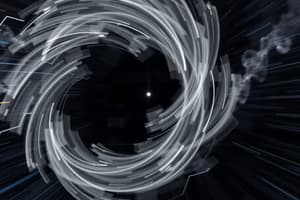Podcast
Questions and Answers
What is the first law of motion known as?
What is the first law of motion known as?
law of inertia
According to Newton's second law, what is the relationship between force and momentum?
According to Newton's second law, what is the relationship between force and momentum?
- Force is the product of mass and acceleration. (correct)
- Force is the rate of change of velocity.
- Force is the product of mass and velocity.
- Force has no relationship with momentum.
The unit of force is Joule.
The unit of force is Joule.
False (B)
What is the equation for force according to Newton's second law?
What is the equation for force according to Newton's second law?
What is impulse measured in?
What is impulse measured in?
Newton's third law states that for every action there is a different reaction.
Newton's third law states that for every action there is a different reaction.
When a bullet is fired from a gun, what reaction does the person firing the gun experience?
When a bullet is fired from a gun, what reaction does the person firing the gun experience?
Momentum is defined as the product of mass and ______.
Momentum is defined as the product of mass and ______.
What is the principle of conservation of linear momentum?
What is the principle of conservation of linear momentum?
What is inertia?
What is inertia?
What action does a rocket perform to propel itself?
What action does a rocket perform to propel itself?
Study Notes
Newton's Laws of Motion
-
Newton's First Law of Motion (Law of Inertia)
- A body at rest will remain at rest, and a body in motion will remain in motion at a constant velocity unless acted upon by an unbalanced force.
- Inertia is the tendency of an object to resist changes in its motion.
-
Newton's Second Law of Motion
- The rate of change of momentum of a body is directly proportional to the applied force and takes place in the direction of the force.
- Force (F) = mass (m) x acceleration (a)
- Impulse (Ft) = change in momentum = m(v-u)
- Momentum (p) = mass (m) x velocity (v)
- The unit of force is Newton (N), which is defined as the force required to give a mass of 1 kg an acceleration of 1 m/s².
-
Newton's Third Law of Motion
- For every action, there is an equal and opposite reaction.
- When one body exerts a force on another, the second body exerts an equal and opposite force on the first body.
- This law explains phenomena like rocket propulsion, the recoil of a gun, and why walking is possible.
Conservation of Linear Momentum
- Momentum is a vector quantity defined as the product of mass and velocity.
- The principle of conservation of linear momentum states that in a closed system, the total momentum before and after a collision is unchanged.
Studying That Suits You
Use AI to generate personalized quizzes and flashcards to suit your learning preferences.
Related Documents
Description
Test your understanding of Newton's Laws of Motion with this quiz. Explore concepts such as inertia, force, and momentum through a series of questions based on the first, second, and third laws. Perfect for students looking to solidify their knowledge in physics.




